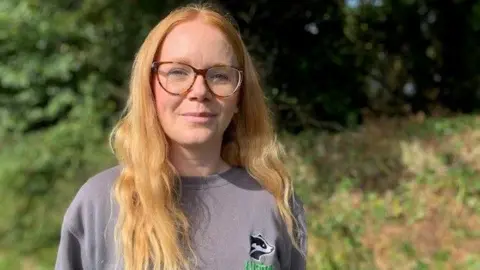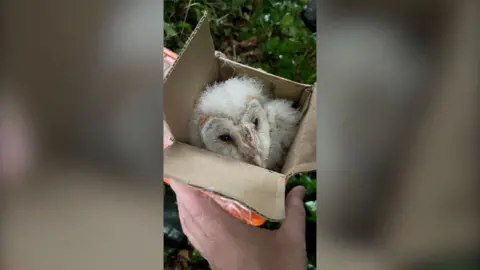Baby barn owl success on County Down farm
 Ulster Wildlife
Ulster WildlifeA County Down farmer is celebrating the arrival of four new barn owl chicks after 10 years of conservation work on his land to increase numbers.
There are currently fewer than 30 breeding pairs of barn owls in Northern Ireland.
Ulster Wildlife say this is down to agricultural intensification, habitat loss, a lack of nest sites, and increased use of rat poisons.
David Sandford has provided a home for nearly 20 owlets in the past six years after installing wooden nest boxes on his farm in Strangford.
David told BBC News NI that he has adapted parts of his land to meet the feeding needs of the birds.
The owls need a good supply of rodents, such as wood mice, field mice, and shrews.
He has turned parts of the land that are not being used for arable farming into wild bird cover with rough grass areas to allow these types of animals to thrive.
He is watching the birds progress through cameras that have been installed inside their nests.
“The barn owls are catching lots of mice, which they are feeding to their young and feeding themselves,” he said.
"They really are pest controllers on steroids."

David reached out to Ulster Wildlife a decade ago when he encountered a barn owl during an evening walk across his fields, and decided he wanted to do more to encourage them to breed on his land.
After the nine nest boxes were installed, nothing happened for around four years.
He says the "eureka moment" came when he heard the "young squeaking in the box, calling for food," and he's had baby barn owls every year since.
But with the highs, there have been lows too.
This year's first brood of chicks on the farm didn't survive, which Ulster Wildlife says "just happens and is nature".

The nest boxes on David's 185-acre farm are used to recreate a natural tree cavity that barn owls would have traditionally nested in.
The RSPB and Ulster Wildlife have praised the farmers efforts in creating a space for the birds to thrive.
Katy Bell from Ulster Wildlife says what has been achieved by David is amazing.
"We've had nearly 20 chicks come from this farm; for such a small population to get almost 20 chicks from just one farm is such a celebration,” she said.

Katy says working with barn owls can be an "emotional rollercoaster," especially after the first batch of chicks hatched in June and all failed.
But the owls moved on to another box and bred again, resulting in the latest batch of owlets.
"Four chicks, that's a really big brood; it makes all our hard work worth it."
 Ulster Wildlife
Ulster Wildlife